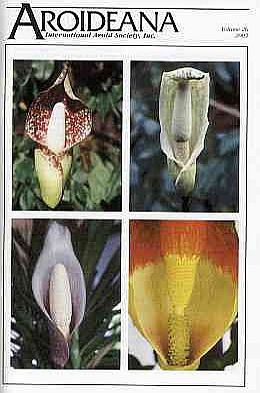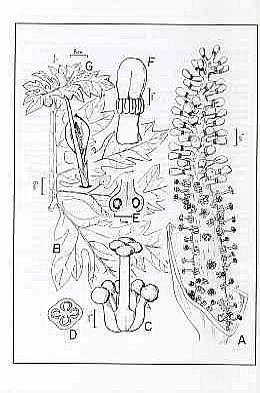|
|



Your search for articles published in volume 26 has found 16 articles.

| 
|
Articles of 3 pages or less are available for free to IAS members for download, and longer articles for $5. Articles from issues in 2016 and beyond are only available electronically, and are free to current members when they are logged in.
Please remember that all Aroideana articles are protected by copyright, and you may NOT distribute even electronic copies without permission from the authors or editor.
(Issue) |
||||
| Thomas B. Croat, C. C. Finch | New species of Anthurium (Araceae) from Colombia (Buy) | |||
| ABSTRACT: Thirty-five years of collecting in Colombia has turned up many species new to science. The now more well-established of these are described for the first time here. Three species are described as new, Anthurium anchicayense Croat, Anthurium cogolloanum Croat & M. M. Mora, and Anthurium salgarense Croat. | ||||
| E. Melendez-Lopez, M. A. Pérez-Farrera, Thomas B. Croat | Additional notes on Anthurium rionegrense Matuda: Morphology (Buy) | |||
| ABSTRACT: The type locality of Anthurium rionegrense is rediscovered and additional information about its morphology, habitat and distribution is presented. This species is a rupiculous plant with a large branched stem. It ranges from 500 to 650 m elevation, occurring in deciduous and semideciduous tropical forests near the borders of the Mexican states of Chiapas and Oaxaca. A new collection locality is also presented. | ||||
| Eduardo G. Gonçalves | Elucidating the elusive Taccarum warmingii (Araceae - Tribe Spathicarpeae) (Buy) | |||
| ABSTRACT: Since it was described by Adolf Engler in 1880, the exact identity of the Brazilian Taccarum warmingii has remained obscure. Recently, the type material of this species was examined and a new collection was made in Espirito Santo state, Eastern BraziL Taccarum warmingii is described in details and illustrated, also based on living specimens now in cultivation. A revised key for the genus Taecarum is also presented. | ||||
| Eduardo G. Gonçalves | A new species and two new combinations for the tribe Spathicarpeae (Araceae) (Buy) | |||
| ABSTRACT: A new species of Asterostigma (A. reticulatum E.G.Gonc.) from Southern Brazil is described and illustrated. Two new Andean combinations are also presented. Spathantheum intermedium Bogner and Taccarum cardenasianum Bogner are transferred to the genus Gorgonidium as G. intermedium (Bogner) E.G.Gonc. and G. cardenasianum (Bogner) E.G.Gonc. respectively, and the arguments for both recombinations are presented. | ||||
| Marc Gibernau, D. Macquart, A. Diaz | Pollen viability and longevity in two species of Arum (Buy) | |||
| ABSTRACT: Pollen-loaded insects are not obligatorily captured rapidly by odoriferous inflorescences after their escape from a 'pollen-donor' inflorescence, but may be caught two or three days later. In such a situation, can these insects be considered as pollinators (Le., pollen vectors) or just visitors? Our results confirm that pollen grains in both species Arum italicum and A. maculatum quickly lose their viability. In natural conditions, pollen must then be dispersed quickly between male phase and female phase inflorescences in order for the pollination to be efficient. In fact, it should happen during the first hours after female psychoda are liberated by male phase inflorescences. This is because pollinators captured on subsequent days would most probably carry non-viable pollen and thus would not pollinate the inflorescence they visit. In natural conditions, pollen grains were viable for two days. By contrast, refrigerated pollen was viable for a longer time (4-5 days). Thus refrigeration at 8 or 15°C appears to be a good method to store pollen and prolong its viability. | ||||
| Wilbert L. A. Hetterscheid, Guy Gusman | Three new Arisaema species from Thailand and some taxonomic/nomenclatural notes (Buy) | |||
| ABSTRACT: Three new Thai species from the genus Arisaema, section Fimbriata, are described and illustrated. Their relations with other species in Fimbriata are discussed and the lectotypification of A. putii Gagnep. is made. | ||||
| R. S. Misra, S. Sriram, M. Nedunchezhiyan, C. Mohandas | Field and storage diseases of Amorphophallus and their management (Buy) | |||
| ABSTRACT: Amorphophallus, commonly known as elephant foot yam or Suran is a dual-purpose aroid ideal for ornamental as well as cultivation purposes. While the plants of all species have ornamental value, tubers of some species are rich source of nutrition and a delicacy as food. Tubers and plants are also used in preparing indigenous medicines for various ailments. The amorphophallus crop has high production potential and market acceptability. Three major field diseases affect the plants; mosaic caused by virus, leaf blight/leaf rot by Phytophthora colocasiae and collar rot by Sclerotium rolfsii. Major field diseases of amorphophallus can be effectively controlled by using disease-free planting material, mulching with paddy straw/plant leaves/black polythene sheets and two preventive sprays with Mancozeb (0.2%) + Monocrotophos (0.05%) at 60 and 90 days after planting. The tubers are also prone to post-harvest damage as a result of infection by various fungi and bacteria coupled with nematode infestation. Tubers infested with Meloidogyne incognita are prone to post-harvest diseases caused by Sclerotium rolfsii, Botryodiplodia theobromae, Phytophthora co!ocasiae, Fusarium and Rhizopus species. A bacterial pathogen, Erwinia carotovora also causes serious soft rot decay of tubers. Storing the tubers by spreading them closely in single layer and covering with coarse dry sand in a cool and ventilated place, followed by periodic removal of damaged tubers/portions, if any, was found to be the best method of storage that allowed minimum decay and weight loss. | ||||
| John Banta | The first hybrid Xanthosoma - Xanthosoma 'Dr. Elliott'
This article available FREE to IAS Members with a PERSONAL login. LOGIN, REGISTER or JOIN | |||
| ABSTRACT: This account of the production of the first hybrid Xanthosoma is offered in hope that other growers will work with this interesting genus. | ||||
| M. Kiehlmann, D. Kiehlmann | Propagation of some aroids by hand pollination with stored pollen (Buy) | |||
| ABSTRACT: Propagation of Amorphophallus beccarii, A. johnsonii, A. eichleri and Anchomanes dalzielii is possible by hand pollination with stored pollen. Dependent on the species and on our practicabilities successful cross or self pollination was achieved with pollen stored from 17 days up to 17 months 19 days. Pollination with unripe pollen of the same inflorescence did not succeed in one case. Pollination with ripe pollen of the same inflorescence succeeded in another case. Some further annotations are made on the said species. | ||||
| Marc Gibernau | Pollinations and visitors of aroid inflorescences (Buy) | |||
| ABSTRACT: Data on aroid pollinators was first summarized by Grayum (1984) who documented 35 genera and about 90 species. A second summary was published in 1997 in The Genera of Araceae (Mayo et al., 1997) with 38 genera and less than 100 species listed including data from Grayum 0986, 1990). This paper brings the reference list up to date since 1997, documenting the pollinators of 49 genera and about 125 species. These numbers are still very low in comparison with the diversity of the Araceae family which contains 105 genera and about 3,300 species. Some questions on aroid pollination are developed in the discussion. | ||||
| Dorothy E. Shaw | Aroid postage stamps of the world. Supplement 2. (Buy) | |||
| ABSTRACT: Postage stamps featuring aroids, or involved with aroid culture or use, omitted from previous publications (Shaw, 1994, 1999), and those issued since, are listed with the country of origin, the dates, the reason for each stamp issue, and with illustrations of many of the stamps. Mistakes in aroid stamps are discussed, particularly two serious cases of mislabelling of scientific names. The total number of stamps for each genus in all three of the publications is also listed. | ||||
| Dorothy E. Shaw | Dimorphic pollen of Alocasia brisbanensis (Araceae) in Queensland (Buy) | |||
| ABSTRACT: Pollen of Alocasia brisbanensis (F. M. Bailey) Domin at Indooroopilly near Brisbane, and at Tolga Scrub ca. 1,400 km NW of Brisbane, was dimorphic. At the time of pollen extrusion it consisted of (1) normal grains with a diameter range of 32.~9.9 J.Lm and a mean of 40.0 J.Lm, with stainable protoplasm, starch and ability to germinate; and (2) small, aborted grains with a diameter range of 19.0-34.2 fJ.m and a mean of 27.7 fJ.m, and without stainable protoplasm, no starch and inviable. At extrusion the amount of aborted grains ranged from 1.8-14.9% (that is, with high variability) with a mean of 6.5%. The amount of aborted grains in buds and during gaping of the spathe was also highly variable but with means of 7.0% and 5.8% respectively, with an average of 6.4% for the 21,201 total grains examined for all stages. | ||||
| M. M. Antofie, A. Brezeanu | In vitro developmental peculiarities of Spathiphyllum (Buy) | |||
| ABSTRACT: A micropropagation protocol for spathiphyllum is described in this article. The original material started from meristem culture and a dynamic of the second to the fourth multiplication stages was analyzed. An exponential growth with a correlation index of R2 = 0.9916 was observed. The multiplication index was positively influenced by the incorporation into the culture medium of BAP (1 mg/D and IAA (0.1 mg/D which gave 26.6 new shoots/explant. A culture medium supplemented only with auxin did not induce callus formation and when only cytokinin was used callusogenesis was positively influenced and rooting processes were not observed. | ||||
| Wilbert L. A. Hetterscheid | Notes on the genus Amorphophallus 12: Three new species from tropical Asia (Buy) | |||
| ABSTRACT: Three new species of Amorphophallus from Asia are described. Their morphological similarities to other species are discussed: Amorphophallus operculatus, Amorphophallus sinuatus, and Amorphophallus vogelianus | ||||
| J. Ehrenberger, Adelheid R. Kuehnle | Enhanced histological technique for observation of spathe pigmentation in Anthurium species and hybrids (Buy) | |||
| ABSTRACT: A total of 12 Anthurium species and hybrids were examined histologically for pigmentation in spathes using a new method employing vacuum infiltration of spathe tissue with polyethylene glycol (PEG) priorto cross-sectioning. PEG infiltration displaces intercellular air spaces between cells. This method greatly improved the clarity of the cross sections and consequently improved observations of spatial localization of anthocyanins and chloroplasts. | ||||
| Anonymous | Errata: Goncalves and Salviani
This article available FREE to IAS Members with a PERSONAL login. LOGIN, REGISTER or JOIN | |||
All Images and Text © 1996 to 2024 by the International Aroid Society or by their respective owners as noted.
Please send your comments to
served by aws-web2
